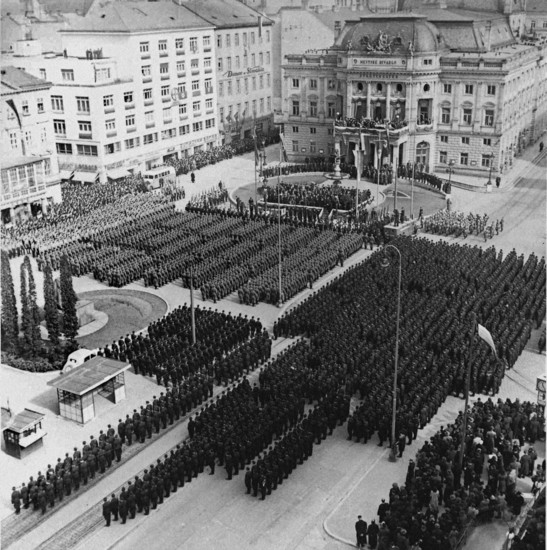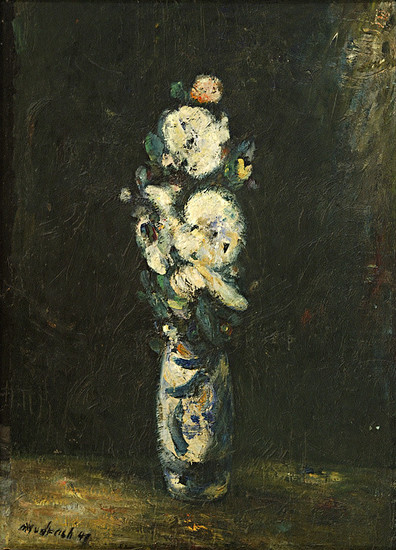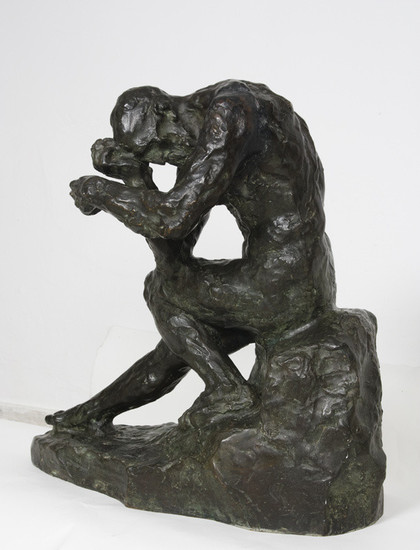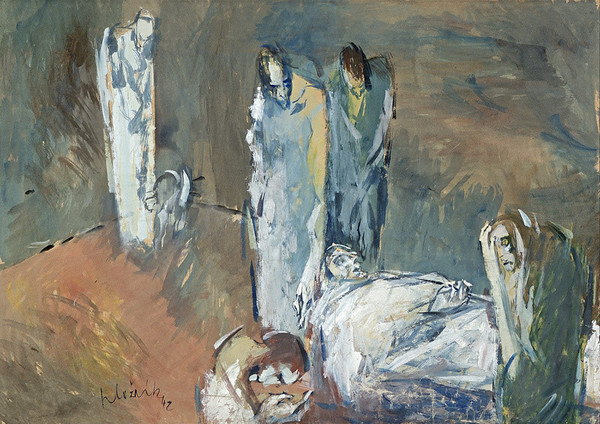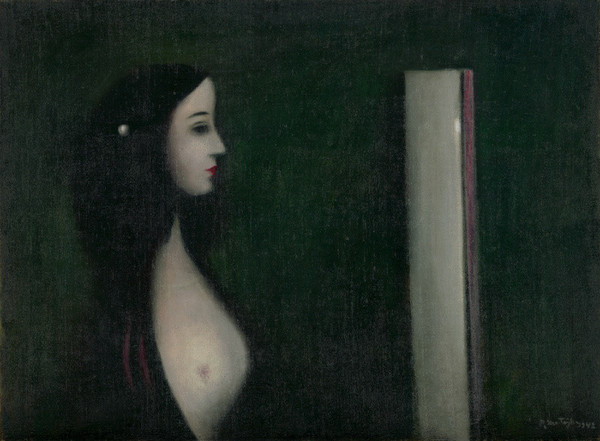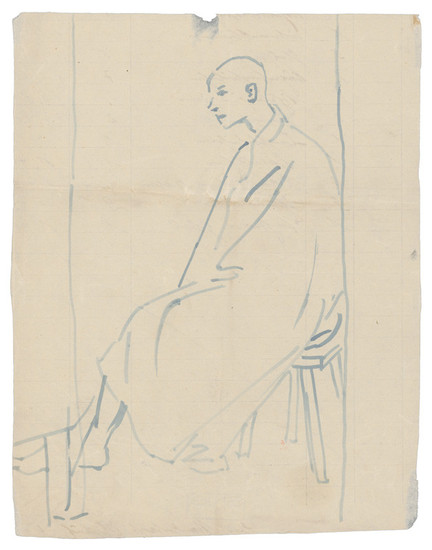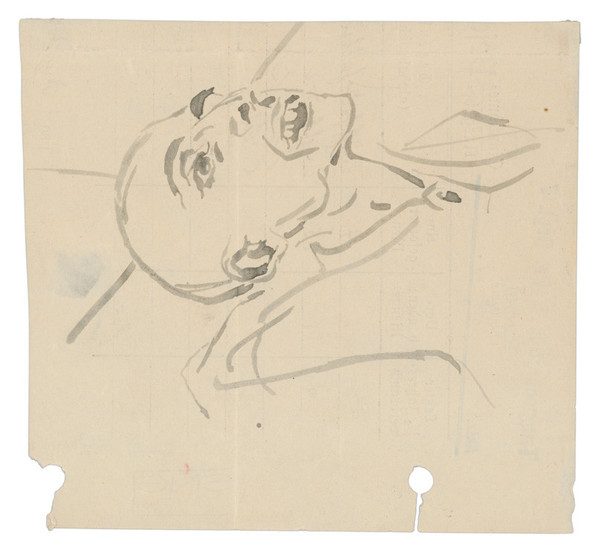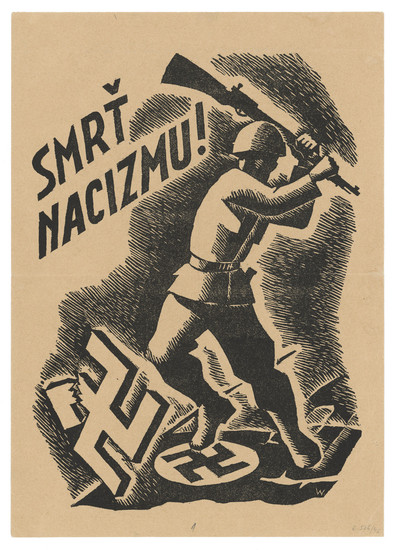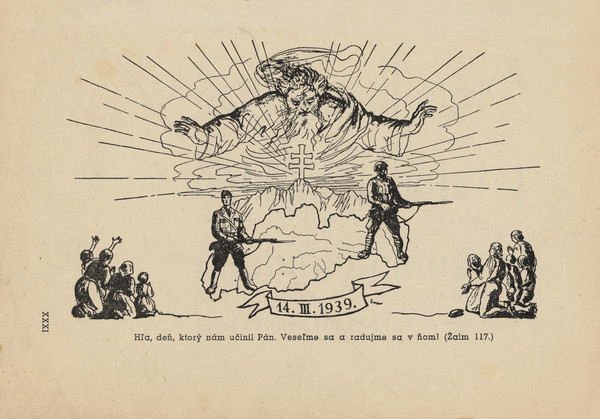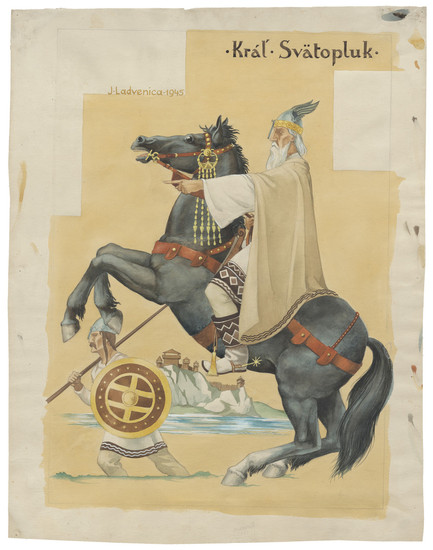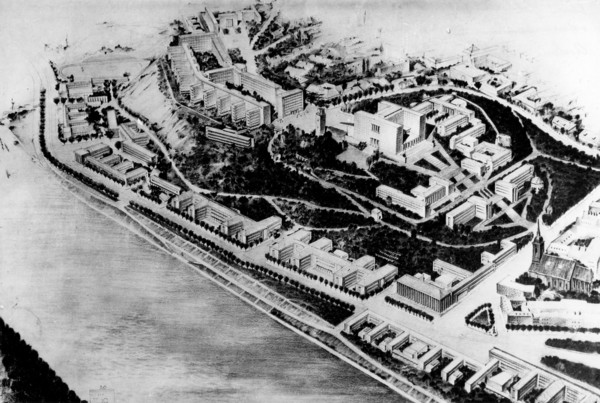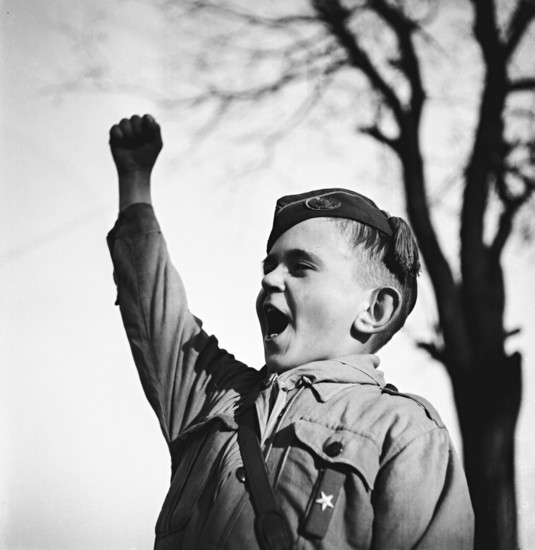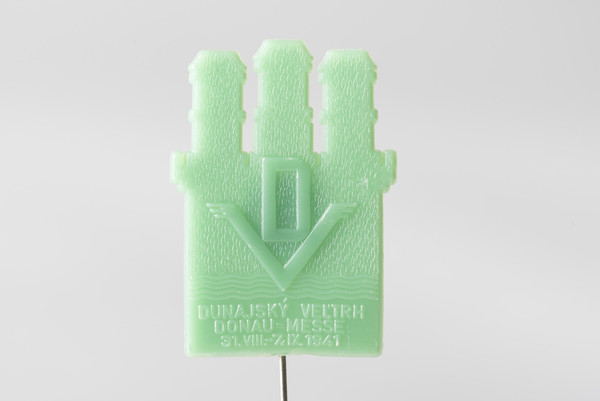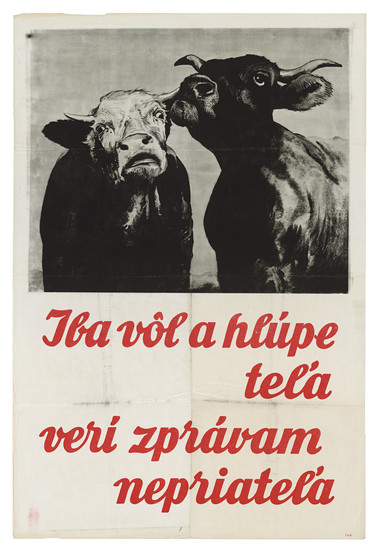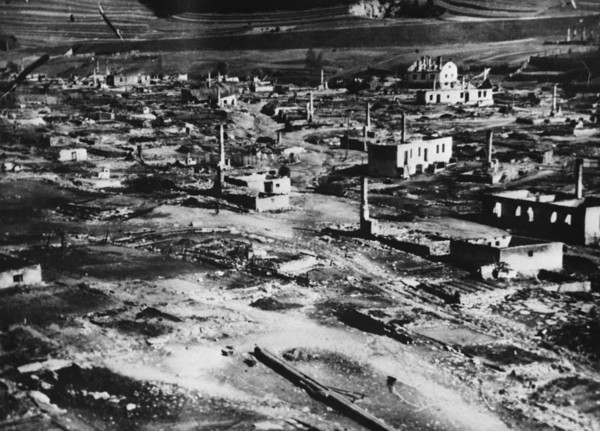Esterházyho palác, 2., 3. poschodie, Bratislava
Curators: Katarína Bajcurová, Petra Hanáková, Bohunka Koklesová
The era of the Slovak (War) State (1939 - 1945) is one of the most controversial periods of our modern history.
Alexandra Kusá, General Director of the SNG:
The exhibition Dream × Reality, which is dedicated to art and propaganda, is the first essential museum contribution to a topic which remains open and traumatizing in many respects. The intention of dealing with the period of 1939 to 1945 has appeared in our exhibition plans for several years. When work on this project began two years ago, none of us had any idea of the mood in society this project would eventually encounter – now we know. This is one of the most difficult projects in the recent history of the Slovak National Gallery due to the fact that our team of curators had to professionally approach a period which has been universally denounced and treated with contempt and disgust by civilized society. The curators were confronted with the complicated task of explaining the complexity of this period, which is like an open wound in our history. After experiencing the reaction to the exhibition dedicated to the 1950s (Prerušená pieseň (Interrupted Song), in 2012, we knew that we were treading on thin ice. Some visitors continue to fail to make the distinction between exhibitions of art and exhibitions of historical documents; they don’t understand or they don’t not want to understand the genre of the art historical exhibition, and its laws and structure. They expect that an exhibition of this type will offer moral condemnation, instructions or at least a confirmation of their own ideas. Instead, we strive to ask questions, to expand awareness and to escort the visitor through a controversial period in which quality art existed side by side with hateful posters, frequently oblivious to each other. We believe that we have succeeded in doing so.
Katarína Bajcurová, Petra Hanáková, Bohunka Koklesová, curators:
The era of the Slovak State (1939 – 1945) is one of the most controversial periods of our modern history. Many recently published books deal with the development of Slovak society in this period from various aspects; however not a single publication or research study has comprehensively examined the artistic history. This exhibition along with its catalogue maps the positions and transformations of the forms and functions of art, visual culture and propaganda in those years. The goal is to present the paradoxes in the functioning of visual art in the network of that regime’s more or less tabooed contexts, and ideological and socio-cultural links that spanned all genres (painting, sculpture, drawing, graphic art, photography, film, applied arts and design); to reflect on the possible dependence – in- dependence (autonomous-ness) of art on society (state, power), the specific features of artistic operations and issues related to propaganda and the visual culture of everyday life.
Art and culture in the Slovak State were not divided into two irreconcilable worlds, one official and one rebellious. Rather, this sphere found itself in a kind of delta of diverse opinions and standpoints that coexisted side by side and reacted to political decisions as well as the experiences and standpoints of the artists themselves. The structure of this exhibition is based on themes while also pursuing a certain chronological framework. It begins with works anticipating the threat of war and fascism and ends with the Uprising and the works which dealt with the regime shortly after the war. The exhibition’s chapters were predetermined by the themes of art and its development on one hand, and the expectations and confrontations of state sponsored patronage and the natural orientation of artistic work. But the proximity of individual works, chapters or rooms point out the various tensions, and the different intentions of individual protagonists. The function of visual art and visual culture in the service of the state is explained here to a great extent, but this position is also questioned by another art which criticizes the reality of those days.
Striving to find answers to questions related to the roles that visual art played – if it could play them at all – within the social organism of the Slovak State (with small steps back to 1938 or forward to 1946) was one of the main goals. Which values did the new regime (as a set of institutions which were part of the state and party machinery, method of government or political system) support and which values were criticized and rejected and through which mechanisms? Which artists were privileged, tolerated and shunned? Which strategies of creation and their communication as well as the strategies of special “existence” did the artist choose in these new cultural and political conditions? Was it careerism, loyalty, chameleonism, indifference to politics, external or internal emigration or simply various degrees of self-fulfillment (in the service of the general public and public interest). How did the artists consciously manage to adapt to period functions and models (state representation, requirements of national and sacral work, peculiarity, etc.), which enabled them to preserve their independence.
From the very first moment, the preparations for this type of exhibition and the material reconstruction of a period at the level of official art (i.e., art supported and promoted by the state) face a basic problem – the lack of sources. The difficulty in finding a portrait of Hitler, which in the past decorated many offices, is understandable. The same is true for the numerous apotheoses of Andrej Hlinka, which we encounter in period newspapers and magazines, busts of immortalized leaders, various kinds of Histories and Mythologies dedicated to ancient Slovaks or the battles of our army on the Eastern front. It all disappeared from public circulation and museum depositories after the war or could only be found with great difficulty. Galleries and their collections, including the Slovak National Gallery, were established after February 1948 when history was rewritten after the liberation, and the Czechoslovak narrative was reconstructed. Fascist “skeletons” were buried and the period of independence of Slovaks was banished from memory. From the perspective of a centralist (soon communist) vanishing point, the rebellious roots of art were favored over “traitorous collaboration.” Purges began shortly after the war and people’s courts were organized to settle the score with the collaborators. Although by no means were all avant-garde artists communists, Modernism somehow made its way into the proletarian line of our art as if it had never collaborated with fascism. In fact, according to the domestic story of art history, it reconstructed and “encouraged” (also through acquisitions) a rather antifascist line, which was not so obvious from the perspective of period artistic discourse, but definitely the most progressive from the artistic perspective.
As far as methodology is concerned, the current discussion, especially on the grounds of historiographic disciplines where new approaches regarding “totalitarian-historical narration” are emerging, became our inspiration. The five years of existence of the Slovak State was indeed too short a period of time, in the course of which the positions of individuals were developing and changing, sometimes quite radically, to establish a simple dichotomous division into the “bad regime” and the innocent, controlled “society.” It was certainly a “bad regime,” but society was far from controlled and manipulated by the government system alone. It actively contributed to its support because the majority accepted the idea of a new and independent statehood whose form and content the regime eventually discredited. This is perhaps the greatest moral contradiction and irony. However, let’s not forget that a certain part of society, including several members of the regime and power structures, eventually rose up in order to clearly express their support for the powers fighting against fascism.
This is not the kind of exhibition which visitors to the Slovak National Gallery are accustomed to attending. Although a gallery is designated for exhibiting art (and our institution is the place for exhibiting “master” art), this time in addition to visual art (painting, sculpture, drawing, photography, architecture and design) the wider field of visual culture is also at the center of attention; and in the case of the Slovak State this means a more intensive overlapping of art and propaganda. The museum format of this exhibition also corresponds with this: it presents not only the “good” works, but also the typical ones (sometimes kitsch) which reveal the nature and dark sides of these ambivalent times. The primary goal is (self)knowledge; aesthetic experience and the “joy” of art is only of secondary importance here. Our aim is to provide a more objective and multi-faceted image that uncovers as much as possible of the contradictory nature and complexity of this period by reflecting the diverse positions of the operations of art and visual culture and even “lack of culture.” None of this would have been possible without the material which represents the dark side of fascist propaganda - because it creates the proper context for works with a different opinion and standpoint.
This is a record-setting project in the history of the SNG in terms of the number of participating institutions: loans for this exhibition come from over 40 galleries, museums, archives and private collections throughout Slovakia.
lab.SNG is preparing an accompanying website which will present the period of the Slovak State from a historical perspective. The first chapter, entitled Half-way on the Road to the Slovak State will be available on October 31, 2016. Interested parties can register at this website in order to receive e-mail notifications regarding the completion of individual chapters.
Galleries and Museums
We would like to thank to the following institutions for lending their works for this exhibition and for providing us with reproduction rights:
Creativo, a. s., Praha;
Fakulta architektúry STU, Ústav dejín a teórie architektúry, Bratislava
Galéria Jána Koniarka, Trnava
Galéria Jozefa Kostku, Bratislava
Galéria mesta Bratislavy, Bratislava
Galéria Miloša Alexandra Bazovského, Trenčín
Galerie výtvarného umění v Ostravě, Ostrava
Liptovská galéria Petra Michala Bohúňa, Liptovský Mikuláš
Malokarpatské múzeum v Pezinku, Pezinok
Ministerstvo vnútra SR – Slovenský národný archív, Bratislava
Ministerstvo vnútra SR – Štátny archív Banská Bystrica
Moravská galerie v Brně, Brno
Múzeum Divadelného ústavu, Bratislava
Múzeum mesta Bratislavy, Bratislava
Múzeum obchodu, Bratislava
Múzeum SNP, Banská Bystrica
Múzeum Vojtecha Löfflera, Košice
Národná banka Slovenska – Múzeum mincí a medailí, Kremnica
Národná banka Slovenska, Bratislava
Národní galerie v Praze, Praha
Oravská galéria v Dolnom Kubíne, Dolný Kubín
Pamiatkový úrad SR, Bratislava
Państwowe Muzeum Auschwitz-Birkenau, Oświęcim
Ponitrianske múzeum, Nitra
Považské múzeum, Žilina
Roman Fecik Gallery, Bratislava
SAV – Ústav dejín umenia, Bratislava
Slovenská národná knižnica – Literárne múzeum, Martin
Slovenské múzeum dizajnu, Bratislava
Slovenské národné múzeum – Archív, Bratislava
Slovenské národné múzeum – Historické múzeum, Bratislava
Slovenské národné múzeum – Múzeá v Martine – Etnografické múzeum, Múzeum Martina Benku
Slovenské národné múzeum – Múzeum Bojnice
Slovenské národné múzeum – Múzeum kultúry karpatských Nemcov, Bratislava
Slovenské národné múzeum – Múzeum Slovenských národných rád, Myjava
Slovenské národné múzeum – Múzeum židovskej kultúry, Bratislava
Slovenské technické múzeum, Košice
Slovenský filmový ústav, Bratislava
Stredoslovenská galéria, Banská Bystrica
Turčianska galéria, Martin
Univerzitná knižnica, Bratislava
Vojenský historický ústav – Vojenský historický archív, Bratislava
Východoslovenská galéria, Košice
Východoslovenské múzeum, Košice
We would also like to thank the private owners of the works.
Dream × Reality | Art & Propaganda 1939 -1945
Curators: Katarína Bajcurová (SNG), Petra Hanáková (SNG), Bohunka Koklesová (AFAD)
Curatorial Cooperation: Miroslav Hrdina, Maroš Schmidt
Expert Cooperation: Alexandra Kusá, Aurel Hrabušický, Jana Švantnerová
Sound Design: Michal Lučenič
Technological Solutions: Peter Gáll, Branislav Horňák, Boris Vitázek
Catalogue Visual Design: Boris Meluš
Exhibition Visual Design: Boris Meluš × Martin Šichman = oximoron
Main partner of the exhibition: Slovenské elektrárne, a.s.
This exhibition was financially supported by the Ministry of Culture of the Slovak Republic and the Bratislava Self-governing Region.
This exhibition is a part of the 2016 Month of Photography.



